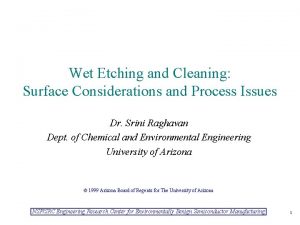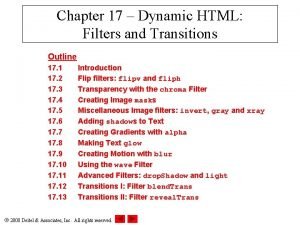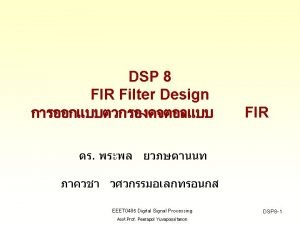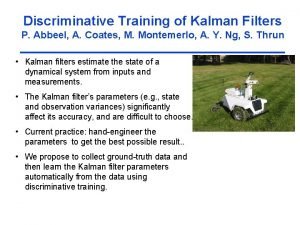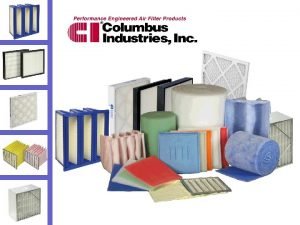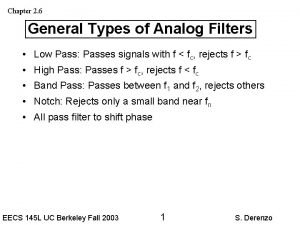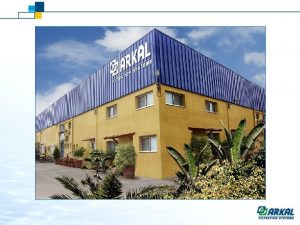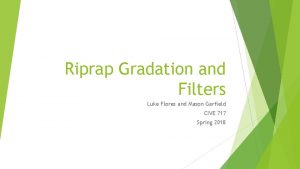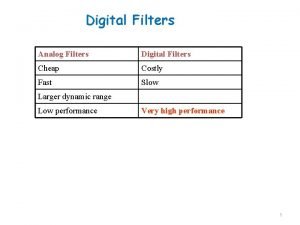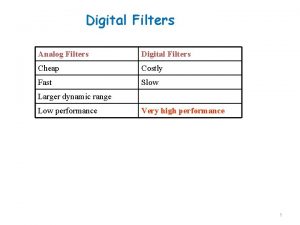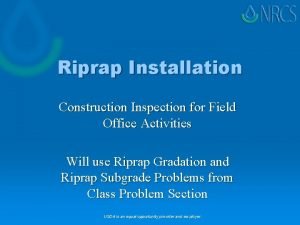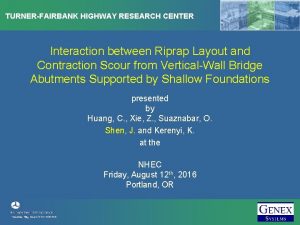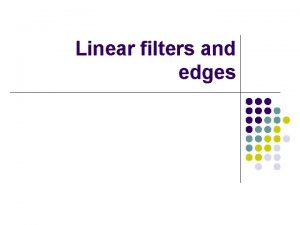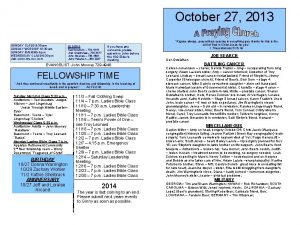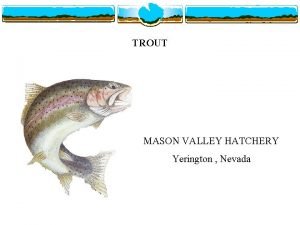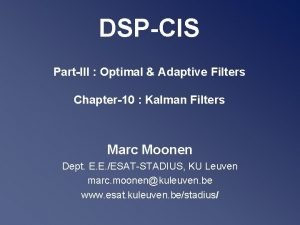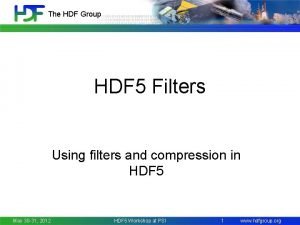Riprap Gradation and Filters Luke Flores and Mason



















- Slides: 19

Riprap Gradation and Filters Luke Flores and Mason Garfield CIVE 717 Spring 2018

Outline

Riprap Definition Riprap refers to rock (usually) that armors stream banks and beds, shorelines, and man-made structures such as piers. Due to its size and weight, riprap can resist the applied shear stresses and does not erode as easily as smaller particles. In effect, an armoring layer is created where finer particles are entrained beneath the coarse, heavy riprap. Example of rock riprap beneath drainage culvert Pros: Usually cheap and widely accessible. Durable and easily constructed Natural aesthetic Cons: Difficult (or impossible) to construct in deep channels or coast lines Example of Detroit riprap when rock is not easily available

Motivation On April 5, 1987 high temperatures resulting in snowmelt combined with 6 inches of rain fell upon the town of Florida, New York. The 50 -year flood drained into the Schoharie Creek which led to the collapse of the Schoharie Creek Bridge. Ten people were killed Investigation concluded that collapse was due ~10 feet of scour which one pier fell into. Engineering designs called for riprap that was sufficiently gradated with a filter around the pier but later determined no filter was applied and representative riprap size was too small. Collapse of Schoharie Creek Bridge Scour around Pier 3

Riprap Gradation Theory Installation of riprap is an engineered armoring layer. A natural armor layer occurs in cycles with fines being mobilized, leaving a coarse layer but installation of riprap simply places a coarse layer over fines with no need for cycles. The idea of Equal Mobility is that finer sized fractions will not move until coarse fractions moved. The idea of riprap is that the coarse riprap will not realistically ever transport at high rates, forever protecting the fines.

Julien (2002) outlines two methods for determining median diameter based on physical arguments (Shear Stress Method and Velocity Method). A plethora of other methods (some physical, some empirical) that are well suited for various situations. Two methods below:

Riprap Gradation Table 1

Riprap Gradation

Riprap Gradation x y

Riprap Filters Required when: d 15 of the riprap gradation exceeds five times the d 85 of the bank material Must be fine enough to prevent the base material from escaping but it must be more permeable than the base layer. Two types of filters: Gravel Synthetic filter cloth

Importance of Filters Prevents migration of fines through voids in the riprap, distributes the weight of the rip rap (more uniform settling) and permits relief of hydrostatic pressures through soils. For areas above the waterline it also prevents runoff from eroding the soil beneath the rip rap. Failure of the riprap can occur without filters such as at the Lewisville Lakes Dam as depicted below caused by erosion of the clay base material under the riprap during a large storm.

Importance of Filters As displayed in the figure from NRCS, filters prevent erosion of the base material, but still allows flow through them to avoid hydrostatic forces on the river bank, preventing a failure of the bank when the riprap is much larger than the bank soil size.

Governing Equations (gravel filters) Equations a, b, and c allows for the filter size between layers to be large enough to prevent hydrostatic pressure on the bank, but small enough to hold the river bank’s material. *The equations are only applicable for non cohesive soil. For cohesive soil the d 15 of the filter cannot exceed 0. 4 mm.

Design of Gravel Filters As seen in the example below the filter’s gradation falls between the base and the riprap. This design accommodates the gradation of the base as well as the riprap and finds a proper sized filter in the double cross-hatched region of the graph between the riprap and the based off of the equations on the previous slide.

Synthetic Filter Cloths Synthetic filter cloths can replace numerous layers of gravel filters with one layer as seen in the figure to the right. Synthetic filter cloths have a variety of number of openings, strength, and durability. https: //www. geosinindo. co. id/application/filtration/

Design of Filter Cloth For many river banks with riprap, non-woven geotextiles are preferred over woven geotextiles especially with slopes greater than 3: 1. Openings of 25% to 30% are desirable to minimize the potential for clogging and to reduce head loss. A blanket of sand or gravel on the filter can be used to protect the filter from punctures by the filter fabric. The sides and the toe of the filter fabric should be sealed or trenched to avoid the bank material from leaching around the filter cloth.

Design of Geotextile Filter Example of Specification requirements for a nonwoven geotextile filter (filter fabric, geotextile liner, or filter cloth) which depends on the size of the aggregate for the rip rap from the Michigan Department of Environmental Quality.

Installation Example Installation of 8 ounce nonwoven geotextile fabric beneath 3’ of riprap at marathon barge terminal in Kenova, WV. The workers below are ensuring that adjacent sections of the fabric are holding together.

References Federal Highway Administration. HEC 11. Design of Riprap Revetment. Julien, P. (2002), River Mechanics, Cambridge University Press Michigan Department of Environmental Quality. Riprap-Stabibilized Outlet. Soil Conservation Service, (1989). Loose Riprap Protection. Minnesota Technical Note 3. United States Army Corps of Engineers Engineering Manual EM 1110 -21601 (1994), Hydraulic Design of Flood and Control Structures. (Obtained and abbreviated by Dr. Christopher Thornton's notes for CSU CIVE 510). State of Colorado’s Riprap Standards table obtained from Front Range Material Inc.
 Caltrans 2010 standard plans
Caltrans 2010 standard plans Sybils group inc
Sybils group inc Wet etch clean filters
Wet etch clean filters Vertical blinds
Vertical blinds Difference between linear and nonlinear spatial filters
Difference between linear and nonlinear spatial filters Time frequency domain
Time frequency domain Lpf hpf
Lpf hpf Impulse invariant method formula
Impulse invariant method formula The origin of language curriculum development
The origin of language curriculum development Filters in weka
Filters in weka Lymph nodes: “filters of the blood”
Lymph nodes: “filters of the blood” Lymph nodes: “filters of the blood”
Lymph nodes: “filters of the blood” Applications of active filters
Applications of active filters Ironport outbreak filters
Ironport outbreak filters Discriminative training of kalman filters
Discriminative training of kalman filters Columbus industries
Columbus industries Types of analog filters
Types of analog filters Disc filters galaxy 4 spin klin series
Disc filters galaxy 4 spin klin series Air solutions cottonwood
Air solutions cottonwood Design of analog filters schaumann
Design of analog filters schaumann


